现代汉语介词连词
- 格式:pdf
- 大小:4.79 MB
- 文档页数:15
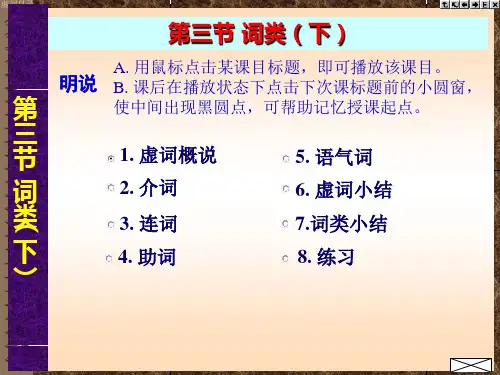

现代汉语的词可以分为12类。
实词:名词、动词、形容词、数词、量词和代词。
虚词:副词、介词、连词、助词、拟声词和叹词。
名词表示人和事物的名称的实词。
如:"黄瓜、白菜、拖拉机、计算机"。
表示抽象事物的名称的抽象名词",如"范畴、思想、质量、品德、友谊、方法"。
方位名词",如"上""下""左""右""前""后""中""东""西""南""北""前面""后边""东边""南面""中间"等。
二.动词表示人或事物的动作、行为、发展、变化。
一般的动作,如"来、去、说、走、跑、学习、起飞、审查、认识"等。
心理活动,如"想、重视、注重、尊敬、了解、相信、佩服、惦念"等,这样的动词前面往往可以加上"很、十分"。
表示能够、愿意这些意思,能愿动词,能、要、应、肯、敢、得(dei)、能够、应该、应当、愿意、可以、可能、必须表示趋向趋向动词",如"来、去、上、下、进、出、上来、上去、下来、下去、过来、过去、起;,它们往往用在一般动词后面表示趋向,如"跳起来、走下去、抬上来、跑过去"。
5、"是""有"也是动词“是”也成为判断动词。
形容词形容词是表示人和事物的形状、性质颜色、状态的词。
例如:表性质的:好、坏、伟大、勇敢、优秀、聪明、老实、鲁莽、大方、软、硬、苦、甜、冷、热、坚固、平常表形状的:长、短、大、小、粗、细、红、绿、平坦、整齐、雪白、笔直、绿油油、血淋淋、骨碌碌、黑不溜秋表状态的:快、慢、生动、熟练、轻松、清楚、马虎、干脆表数量的:许多、好些、全部、全、整、多、少形容词的语法特点:1.大部分形容词能同程度副词组合,例如“很勇敢”、“非常整齐”、“太死板”、“最清楚”等。

连词与介词的区别我们在学习一种语言的时候经常会学习的语言的语法,那么你知道连词和介词的区别是什么吗?下面是店铺为你整理的连词与介词的区别,供大家阅览!介词和连词的区别:介词不能单独作句子成分,但介词在介词短语中是两个实质性结构成分中(介词+名词性词语)的一个;而连词在实质性结构中只起连接作用。
下面以“和”为例谈谈如何区别介词和连词。
①当“和”作介词的时候,“和”前后的成分不能互换,前面可加副词作状语,后面可以有停顿。
②当“和”作连词的时候,“和”前后的成分可以互换,前面不能加副词性修饰成分,后面不能停顿。
一、介词的分类与语法功能1. 介词是虚词,不能单独作句子成分,必须与名词、代词(或相当于名词的其他词类、短语或从句等)构成介词短语,在句中充当一个成分。
介词分为:① 简单介词,如at、in、for等;② 合成介词,如within、inside、onto、througout等;③ 短语介词,如according to、out of、because of、by means of、in spite of、instead of等。
④ 双重介词,如from behind / above / under、until after等。
⑤ 分词介词,如considering、including、judging(from / by) 等。
常见的介词宾语:名词、代词、动名词、从句、不定式等。
如:①It is going to rain this afternoon according to the weather forecast.②He quarrelled w ith her yesterday.③He succeeded in passing the final exam.④I’m still thinking of how I can fulfil the task ahead of time.⑤The professor will give us a talk on how to study English well.2. 介词短语在句中可作表语、定语、状语和宾补等。

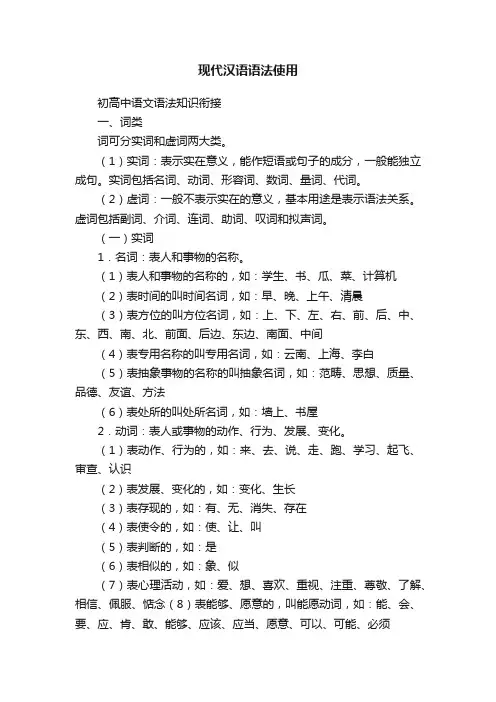
现代汉语语法使用初高中语文语法知识衔接一、词类词可分实词和虚词两大类。
(1)实词:表示实在意义,能作短语或句子的成分,一般能独立成句。
实词包括名词、动词、形容词、数词、量词、代词。
(2)虚词:一般不表示实在的意义,基本用途是表示语法关系。
虚词包括副词、介词、连词、助词、叹词和拟声词。
(一)实词1.名词:表人和事物的名称。
(1)表人和事物的名称的,如:学生、书、瓜、菜、计算机(2)表时间的叫时间名词,如:早、晚、上午、清晨(3)表方位的叫方位名词,如:上、下、左、右、前、后、中、东、西、南、北、前面、后边、东边、南面、中间(4)表专用名称的叫专用名词,如:云南、上海、李白(5)表抽象事物的名称的叫抽象名词,如:范畴、思想、质量、品德、友谊、方法(6)表处所的叫处所名词,如:墙上、书屋2.动词:表人或事物的动作、行为、发展、变化。
(1)表动作、行为的,如:来、去、说、走、跑、学习、起飞、审查、认识(2)表发展、变化的,如:变化、生长(3)表存现的,如:有、无、消失、存在(4)表使令的,如:使、让、叫(5)表判断的,如:是(6)表相似的,如:象、似(7)表心理活动,如:爱、想、喜欢、重视、注重、尊敬、了解、相信、佩服、惦念(8)表能够、愿意的,叫能愿动词,如:能、会、要、应、肯、敢、能够、应该、应当、愿意、可以、可能、必须3.形容词:表人或事物的形状、样式、性质(1)表事物的形状,如:高、矮、胖、瘦、大、小(2)表事物的性质,如:美、丑、恶、甜、苦、好、坏、奢侈(3)表事物的状态,如:快、慢、迅速4.数词:表人或事物数目的词。
(1)表确数的,如:一、十、亿、半(2)表概数的,如:几、一些、上万(3)表序数的,如:第一、老九(4)表分数的,如:三分之一、七成5.量词:表人、事物的单位或动作、行为的单位的词。
(1)表物量的,如:个、张、只、支、寸、吨(2)表动量的,如:次、下、回、趟、场6.代词:起代替或指示作用的词。
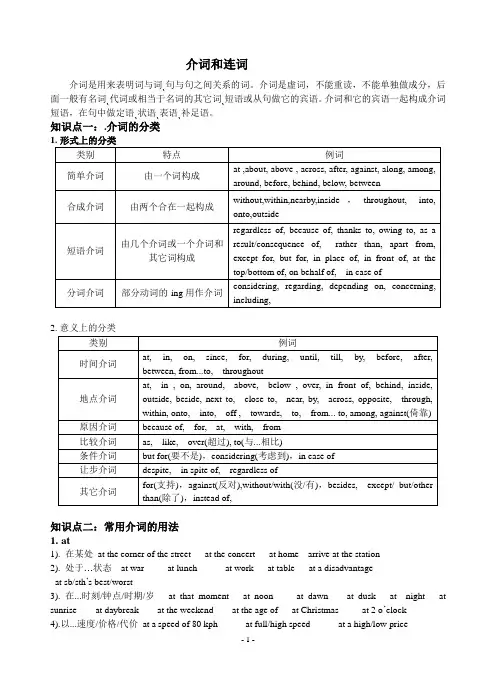
介词和连词介词是用来表明词与词ˎ句与句之间关系的词。
介词是虚词,不能重读,不能单独做成分,后面一般有名词ˎ代词或相当于名词的其它词ˎ短语或从句做它的宾语。
介词和它的宾语一起构成介词短语,在句中做定语ˎ状语ˎ表语ˎ补足语。
知识点一:.介词的分类1.形式上的分类类别特点例词简单介词由一个词构成at ,about, above , across, after, against, along, among, around, before, behind, below, between合成介词由两个合在一起构成without,within,nearby,inside,throughout, into, onto,outside短语介词由几个介词或一个介词和其它词构成regardless of, because of, thanks to, owing to, as aresult/consequence of, rather than, apart from,except for, but for, in place of, in front of, at thetop/bottom of, on behalf of, in case of分词介词部分动词的-ing用作介词considering, regarding, depending on, concerning, including,2.意义上的分类类别例词时间介词at, in, on, since, for, during, until, till, by, before, after, between, from...to, throughout地点介词at, in , on, around, above, below , over, in front of, behind, inside, outside, beside, next to, close to, near, by, across, opposite, through, within, onto, into, off , towards, to, from... to, among, against(倚靠)原因介词because of, for, at, with, from比较介词as, like, over(超过), to(与...相比)条件介词but for(要不是),considering(考虑到),in case of 让步介词despite, in spite of, regardless of其它介词for(支持),against(反对),without/with(没/有),besides, except/ but/other than(除了),instead of,知识点二:常用介词的用法1.at1). 在某处at the corner of the street at the concert at home arrive at the station2). 处于…状态at war at lunch at work at table at a disadvantageat sb/sth’s best/worst3). 在...时刻/钟点/时期/岁at that moment at noon at dawn at dusk at night at sunrise at daybreak at the weekend at the age of at Christmas at 2 o’clock4).以...速度/价格/代价at a speed of 80 kph at full/high speed at a high/low priceat the expense of at a rate of5).at+名词表示“一......就”at the sight of at the sound of at the thought of6).at与动词连用,表示“对/朝/向(目标,方向等) ”aim at laugh at shoot atthrow sth at point sth at7)表示“应......邀请/请求/号召/吩咐”at our request at the chairman’s invitationat one’s command8).与形容词连用,表“因...而”“在...方面”be surprised at sth be astonished at sthbe shocked at be angry at be disappointed at sth be good at paintingbe delighted at the result be impatient at the delay9).其它:call me at 637-22332.in1). 在...时间内in the morning/afternoon/evening in spring/summer/autumn/winterin the fall of 2016 in January2). 在(某段时间)之后in a few days in a month in a week’s time3). 在...空间/范围内in Africa be lying in bed read about the accident in the newspaper4). 处于...状态in good/bad condition in a good state in danger in debtin despair in ruins in trouble in use in operation in preparation in love5). 表示使用语言,材料等say it in English in pencil put it in writing pay in cash speak in a loud voice6). 其它:be dressed in their best clothes in a row three metres in length in tearsin an attempt to in total in comfort in conclusion in consequence in principlein depth in detail in disguise in effect in practice in existence in casein store in person in place in need in demand in order in sight3.on1). (覆盖,附着)在...之上(尤指某物的表面上) on the wall on the Thameson the surface of the lake hit sb on the head2). 表时间,在特定的日子里on Sunday on May the first on the morning of March 8thOn Christmas Day on your birthday on one occasion3). 关于give a talk on the economic situation differ from each other on some important mattersa ban on smoking4). 处于活动或状态中be on business/holiday/vacation a soldier on watch be on fire5). 按照,凭,根据,靠act on his advice live on rice be based on facts6). 就在...之后,一...就(后接名词或动名词) on his arrival/return on arriving homeon hearing the news7). 其它:stand on one foot hang your coat on that hook come on my bike Have you got any money on you be on the committee on our sidetalk on the telephone a town on the coast4.for1). 为了,给,替(表示目的,对象) come here for advice prepare for a meetinga book intended for children a knife for cutting breadHere’s a letter for you wok for IBM2). 历经,计,达(表示时间,距离,数量) The bad weather has lasted for an entire weekwalk for miles3). 支持,赞成Are you for or against the proposal? vote for giving up smoking4). 由于,因为be famous for its hot springs be praised for his good deedsget an award for bravery5). 当做,作为What did you have for lunch? Don’t take him for a foolYou must have mistaken me for Lisa6). 其它:. I’ll swap these two bottles for that one. That’s too much responsibility for a child The box is too heavy for me to lift They are anxious for her safetyShe has an ear for music have a gift for writingfor ever永远地for sale for free/nothing免费for all 虽然,尽管5.by1). 在...旁边,靠近stand by the window Come and sit by me2). 用,靠,通过,借助于(表示方式,手段) by train/air/plane/sea/ship/land/bus/carmake a living by selling newspapers know sb by name pay by chequecontact you by letter or by telephone3). 不迟于,在...之前return the book by FridayBy the time this letter reaches you ,I will have left the country.4). 按照,以(表示数量,尺寸,程度等,单位词前用the) be paid by the day/hoursell it by the meter judge a man by his looks/clothes5) 表示程度,数量The bullet missed him by two inches(子弹以两英寸之差未击中他)He is taller than his father by a head/two centimetersHouse prices went up by 10%6). 表示触及或抓住的人或物的部分take him by the hand seize him by the hairpick it up by the handle7). 其它:be knocked by a bus meet by chance take my umbrella by mistakewith time going by work by candlelight6.against1). 以......为背景,衬托。
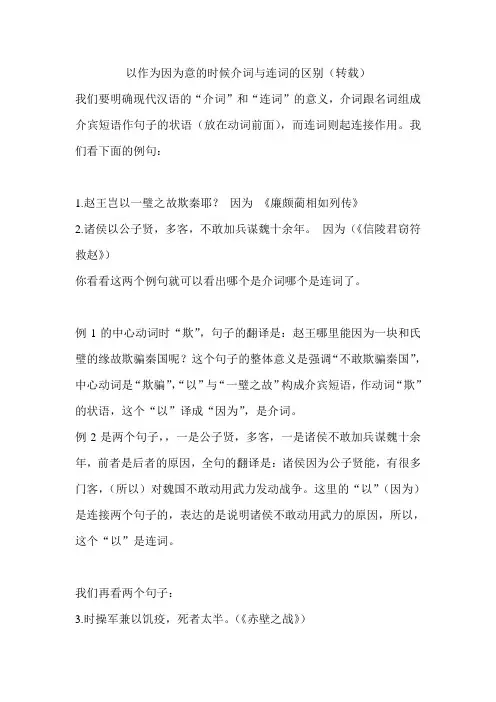
以作为因为意的时候介词与连词的区别(转载)我们要明确现代汉语的“介词”和“连词”的意义,介词跟名词组成介宾短语作句子的状语(放在动词前面),而连词则起连接作用。
我们看下面的例句:1.赵王岂以一璧之故欺秦耶?因为《廉颇蔺相如列传》2.诸侯以公子贤,多客,不敢加兵谋魏十余年。
因为(《信陵君窃符救赵》)你看看这两个例句就可以看出哪个是介词哪个是连词了。
例1的中心动词时“欺”,句子的翻译是:赵王哪里能因为一块和氏璧的缘故欺骗秦国呢?这个句子的整体意义是强调“不敢欺骗秦国”,中心动词是“欺骗”,“以”与“一璧之故”构成介宾短语,作动词“欺”的状语,这个“以”译成“因为”,是介词。
例2是两个句子,,一是公子贤,多客,一是诸侯不敢加兵谋魏十余年,前者是后者的原因,全句的翻译是:诸侯因为公子贤能,有很多门客,(所以)对魏国不敢动用武力发动战争。
这里的“以”(因为)是连接两个句子的,表达的是说明诸侯不敢动用武力的原因,所以,这个“以”是连词。
我们再看两个句子:3.时操军兼以饥疫,死者太半。
(《赤壁之战》)4.顾吾念之,强秦之所以不敢加兵于赵者,徒以吾两人在也。
《廉颇蔺相如列传》例3的“以”翻译成“因为”,但它是中心动词“死者”前面的修饰成分(原因),不起“连接”作用,是介词。
例4的“以”翻译成“因为”,它不是与“两人”一起组成介宾短语作“在”的修饰成分,而是“连接”“不敢加兵于赵”和“两人在”这两个句子,表明因果关系的,所以,这个“以”是连词。
其实,文言虚词理解的关键是语言环境,句子的上下文。
简单地讲连词主要是用于连接前后两者的关系,因此在表达上往往会具有词性的相似性,或者表达方式上的承接关联性;注意:承接性至于介词以字前后的词句往往也没有承接的关联,反而是一种使用于被使用的感觉。
还有一点就是介词后只能带名词(名词性短语)或代词,不能带主谓短语。
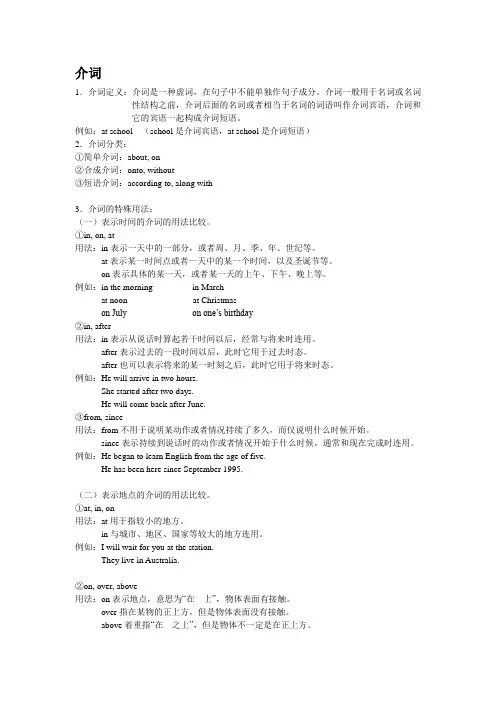
介词1.介词定义:介词是一种虚词,在句子中不能单独作句子成分。
介词一般用于名词或名词性结构之前,介词后面的名词或者相当于名词的词语叫作介词宾语,介词和它的宾语一起构成介词短语。
例如:at school (school是介词宾语,at school是介词短语)2.介词分类:①简单介词:about, on②合成介词:onto, without③短语介词:according to, along with3.介词的特殊用法:(一)表示时间的介词的用法比较。
①in, on, at用法:in表示一天中的一部分,或者周、月、季、年、世纪等。
at表示某一时间点或者一天中的某一个时间,以及圣诞节等。
on表示具体的某一天,或者某一天的上午、下午、晚上等。
例如:in the morning in Marchat noon at Christmason July on one’s birthday②in, after用法:in表示从说话时算起若干时间以后,经常与将来时连用。
after表示过去的一段时间以后,此时它用于过去时态。
after也可以表示将来的某一时刻之后,此时它用于将来时态。
例如:He will arrive in two hours.She started after two days.He will come back after June.③from, since用法:from不用于说明某动作或者情况持续了多久,而仅说明什么时候开始。
since表示持续到说话时的动作或者情况开始于什么时候,通常和现在完成时连用。
例如:He began to learn English from the age of five.He has been here since September 1995.(二)表示地点的介词的用法比较。
①at, in, on用法:at用于指较小的地方。
in与城市、地区、国家等较大的地方连用。
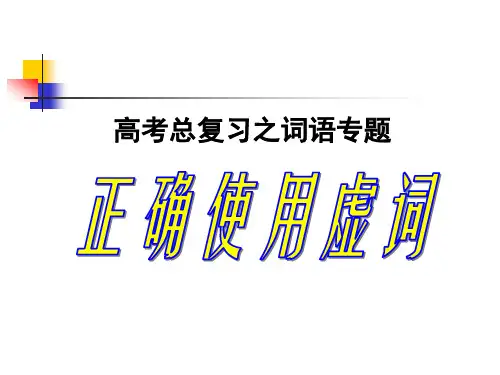

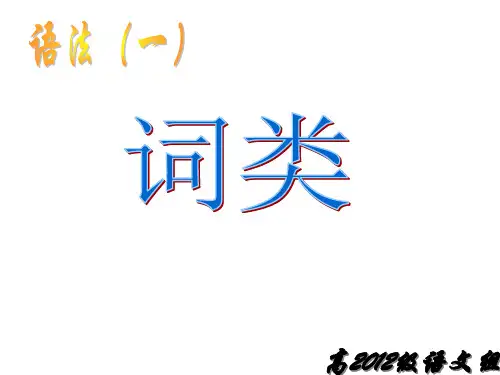
连词和介词的区别1."和、跟、同、与",有时是连词、有时是介词,而且属兼类词,所以很难区别。
例如:[1]弟弟跟妹妹都走了。
(连词)[2]弟弟跟妹妹借书。
(介词)区别的方法有三点(1)"连词前后成分平等,可以互换位置而语义基本不变,而介词前后成分则有主有次,不能互换,否则意思全变了。
例如,[1]弟弟跟妹妹都走了。
=妹妹跟弟弟都走了。
[2]弟弟跟妹妹借书。
≠妹妹跟弟弟借书。
(2)如果谓语部分有"都"、"全"、"一起"等词语,则前面的"和、跟、同、与"必是连词,例如"弟弟跟妹妹都借书",其中"跟"即为连词。
(3)如果是介词,它前面可以加上某些副词状语,而连词之前则不行。
例如:[1]弟弟跟妹妹都走了。
→弟弟老跟妹妹都走了。
[2]弟弟跟妹妹借书。
→弟弟老跟妹妹借书。
[注意]:"和、跟、同、与"有的分工:"和"常作连词,"同"常作介词,"跟"口语中使用,"与"书面语中使用。
例如:[1]我国同美国和日本等国情不同。
[2]你别跟我来这一套。
[3]酒与文学(文章标题)介词与连词的区别:和、跟、与、同(1)连词所连前后项平等并列关系,共作同一成分,位置互换而意义不变,介词则否;(2)介词前可出现修饰语(状语),连词则否;(3)介词之前成分可省略,连词则否;(4)连词所连后项之后可有“都、也、全”等,介词则否大多数情况下,连词与介词是很好区别的,关键是要把握住二者的语法特征:连词起连接作用,它所连接的前后两部分词性肯定是相同的,如“跑和跳”“你或者我”;介词是介绍作用,在句子成分中,在动词谓语之前,则充当状语,之后则充当补语。
现举几个例子加以分析:1、我和妈妈到超市买东西。
连词与介词的区别导读:我根据大家的需要整理了一份关于《连词与介词的区别》的内容,具体内容:我们在学习一种语言的时候经常会学习的语言的语法,那么你知道连词和介词的区别是什么吗?下面是我为你整理的,供大家阅览!介词和连词的区别:介词不能单独作句子成分,但介词在介词短语中是两个实质性...我们在学习一种语言的时候经常会学习的语言的语法,那么你知道连词和介词的区别是什么吗?下面是我为你整理的,供大家阅览!介词和连词的区别:介词不能单独作句子成分,但介词在介词短语中是两个实质性结构成分中(介词+名词性词语)的一个;而连词在实质性结构中只起连接作用。
下面以"和"为例谈谈如何区别介词和连词。
①当"和"作介词的时候,"和"前后的成分不能互换,前面可加副词作状语,后面可以有停顿。
②当"和"作连词的时候,"和"前后的成分可以互换,前面不能加副词性修饰成分,后面不能停顿。
一、介词的分类与语法功能1. 介词是虚词,不能单独作句子成分,必须与名词、代词(或相当于名词的其他词类、短语或从句等)构成介词短语,在句中充当一个成分。
介词分为:① 简单介词,如at、in、for等;② 合成介词,如within、inside、onto、througout等;③ 短语介词,如according to、out of、because of、by means of、in spite of、instead of等。
④ 双重介词,如from behind / above / under、until after等。
⑤ 分词介词,如considering、including、judging(from / by) 等。
常见的介词宾语:名词、代词、动名词、从句、不定式等。
如:①It is going to rain this afternoon according to the weather forecast.②He quarrelled with her yesterday.③He succeeded in passing the final exam.④Im still thinking of how I can fulfil the task ahead of time.⑤The professor will give us a talk on how to study English well.2. 介词短语在句中可作表语、定语、状语和宾补等。